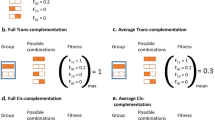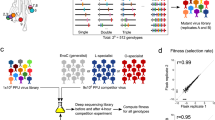Abstract
Given the difficulty of testing evolutionary and ecological theory in situ, in vitro model systems are attractive alternatives1; however, can we appraise whether an experimental result is particular to the in vitro model, and, if so, characterize the systems likely to behave differently and understand why? Here we examine these issues using the relationship between phenotypic diversity and resource input in the T7–Escherichia coli co-evolving system as a case history. We establish a mathematical model of this interaction, framed as one instance of a super-class of host–parasite co-evolutionary models, and show that it captures experimental results. By tuning this model, we then ask how diversity as a function of resource input could behave for alternative co-evolving partners (for example, E. coli with lambda bacteriophages). In contrast to populations lacking bacteriophages, variation in diversity with differences in resources is always found for co-evolving populations, supporting the geographic mosaic theory of co-evolution2. The form of this variation is not, however, universal. Details of infectivity are pivotal: in T7–E. coli with a modified gene-for-gene interaction, diversity is low at high resource input, whereas, for matching-allele interactions, maximal diversity is found at high resource input. A combination of in vitro systems and appropriately configured mathematical models is an effective means to isolate results particular to the in vitro system, to characterize systems likely to behave differently and to understand the biology underpinning those alternatives.
This is a preview of subscription content, access via your institution
Access options
Subscribe to this journal
Receive 51 print issues and online access
$199.00 per year
only $3.90 per issue
Buy this article
- Purchase on Springer Link
- Instant access to full article PDF
Prices may be subject to local taxes which are calculated during checkout




Similar content being viewed by others
References
Jessup, C. M. et al. Big questions, small worlds: microbial model systems in ecology. Trends Ecol. Evol. 19, 189–197 (2004)
Thompson, J. The Geographic Mosaic of Coevolution (Chicago Univ. Press, Chicago, 2005)
Kruger, D. H. & Schroeder, C. Bacteriophage T3 and bacteriophage T7 virus–host cell interactions. Microbiol. Rev. 45, 9–51 (1981)
Wade, M. J. The co-evolutionary genetics of ecological communities. Nature Rev. Genet. 8, 185–195 (2007)
Buckling, A. & Rainey, P. B. Antagonistic coevolution between a bacterium and a bacteriophage. Proc. R. Soc. Lond. B 269, 931–936 (2002)
Agrawal, A. & Lively, C. M. Infection genetics: gene-for-gene versus matching-alleles models and all points in between. Evol. Ecol. Res. 4, 79–90 (2002)
Morgan, A. D., Gandon, S. & Buckling, A. The effect of migration on local adaptation in a coevolving host–parasite system. Nature 437, 253–256 (2005)
Chao, L., Levin, B. R. & Stewart, F. M. Complex community in a simple habitat — experimental-study with bacteria and phage. Ecology 58, 369–378 (1977)
Forde, S. E., Thompson, J. N. & Bohannan, B. J. M. Adaptation varies through space and time in a coevolving host–parasitoid interaction. Nature 431, 841–844 (2004)
Qimron, U., Marintcheva, B., Tabor, S. & Richardson, C. C. Genomewide screens for Escherichia coli genes affecting growth of T7 bacteriophage. Proc. Natl Acad. Sci. USA 103, 19039–19044 (2006)
Sasaki, A. & Godfray, H. C. J. A model for the coevolution of resistance and virulence in coupled host–parasitoid interactions. Proc. R. Soc. Lond. B 266, 455–463 (1999)
Tamaki, S., Sato, T. & Matsuhas, M. Role of lipopolysaccharides in antibiotic resistance and bacteriophage adsorption of Escherichia coli K-12 . J. Bact. 105, 968–975 (1971)
Sen, K. & Nikaido, H. Lipopolysaccharide structure required for in vitro trimerization of Escherichia coli Ompf porin. J. Bact. 173, 926–928 (1991)
Poullain, V., Gandon, S., Brockhurst, M. A., Buckling, A. & Hochberg, M. E. The evolution of specificity in evolving and coevolving antagonistic interactions between a bacteria and its phage. Evolution 62, 1–11 (2008)
Bohannan, B. J. M., Kerr, B., Jessup, C. M., Hughes, J. B. & Sandvik, G. Trade-offs and coexistence in microbial microcosms. Anton Leeuw. Int. J. G. 81, 107–115 (2002)
Yoshida, T., Hairston, N. G. & Ellner, S. P. Evolutionary trade-off between defence against grazing and competitive ability in a simple unicellular alga, Chlorelia vulgaris . Proc. R. Soc. Lond. B 271, 1947–1953 (2004)
Ferris, M. T., Joyce, P. & Burch, C. L. High frequency of mutations that expand the host range of an RNA virus. Genetics 176, 1013–1022 (2007)
Weitz, J. S., Hartman, H. & Levin, S. A. Coevolutionary arms races between bacteria and bacteriophage. Proc. Natl Acad. Sci. USA 102, 9535–9540 (2005)
Spanakis, E. & Horne, M. T. Co-adaptation of Escherichia coli and coliphage lambda vir in continuous culture. J. Gen. Microbiol. 133, 353–360 (1987)
Lenski, R. E. & Levin, B. R. Constraints on the coevolution of bacteria and virulent phage — a model, some experiments, and predictions for natural communities. Am. Nat. 125, 585–602 (1985)
Forde, S. E., Thompson, J. N. & Bohannan, B. J. Gene flow reverses an adaptive cline in a coevolving host-parasitoid interaction. Am. Nat. 169, 794–801 (2007)
Acknowledgements
We thank A. Buckling, S. Nuismer, K. Rich, J. Hoeksema and C. Jessup for their comments on an earlier version of this manuscript. L.D.H. is a Royal Society Wolfson Research Merit Award Holder. I.G. is supported by a NERC Advanced Fellowship. S.S.A. is funded by an ORS award and a studentship for the Department of Mathematics at Imperial College London. S.E.F. and J.N.T. are supported by the National Science Foundation DEB 0515598.
Author information
Authors and Affiliations
Corresponding author
Supplementary information
Supplementary Information
This file contains Supplementary Discussion and Supplementary Figures 1-11. The file contains the following sections: 1. Introduction; 2. The mathematical model; 3. Measuring diversity generated by the model: a rationale; 4. Equilibrium structure of the model; 5. E.coli-T7 case study; 6. Alternative diversity curves; 7. Comments. The Supplementary Information defines the class of mathematical models of bacteria-page co-evolution and shows that there is at least one system that fits the mean experimental data. It then asks, within the entire class of models proposed, which features of E.coli-T7 interaction are universal to all models and which are system specific. (PDF 676 kb)
Rights and permissions
About this article
Cite this article
Forde, S., Beardmore, R., Gudelj, I. et al. Understanding the limits to generalizability of experimental evolutionary models. Nature 455, 220–223 (2008). https://doi.org/10.1038/nature07152
Received:
Accepted:
Issue Date:
DOI: https://doi.org/10.1038/nature07152
This article is cited by
-
Antibiotic collateral sensitivity is contingent on the repeatability of evolution
Nature Communications (2019)
-
Dynamic biofilm architecture confers individual and collective mechanisms of viral protection
Nature Microbiology (2017)
-
Dispersal network structure and infection mechanism shape diversity in a coevolutionary bacteria-phage system
The ISME Journal (2014)
-
Many Possible Worlds: Expanding the Ecological Scenarios in Experimental Evolution
Evolutionary Biology (2011)
-
Genetics and the understanding of selection
Nature Reviews Genetics (2009)
Comments
By submitting a comment you agree to abide by our Terms and Community Guidelines. If you find something abusive or that does not comply with our terms or guidelines please flag it as inappropriate.



